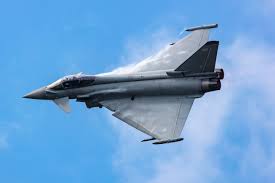Italy, the UK, and Japan Are Racing to Field a Joint Sixth-Gen Fighter

The future fighter, dubbed the Global Combat Air Program, will replace the Eurofighter Typhoon and the Japanese fleet of F-2 fighters.
While the U.S. Air Force continues to make steady progress with its Next-Generation Air Dominance (NGAD) program, other countries’ near-peer sixth-generation endeavors are also making headway. The United Kingdom, Italy, and Japan are racing to field their NGAD counterpart, dubbed the Global Combat Air Program (GCAP).
This collaborative fighter program was initially conceptualized back in 2022. However, Pakistan’s reported successful deployment of Chinese-made fighters in its recent skirmish with India has ramped up the more imminent need for GCAP’s arrival. According to the South China Morning Post, the turbocharged effort to produce GCAP indicates growing concern over Beijing’s aerial prowess. Although the exact impetus driving the sudden surge in GCAP is unknown, progress surrounding Beijing and Washington’s concurrent sixth-gen programs is most likely a factor.
“We expect to receive our first international contract this year against relatively stable, high level requirements, which is what’s required to disaggregate the work allocation,” Andrew Howard, director for Future Combat Air at Leonardo UK, said about GCAP. As detailed by Breaking Defense, four firms are expected to deliver the sixth-generation fighter’s Integrated Sensing and Non-Kinetic Effects & Integrated Communications Systems package in the near future. ELT Group, Italy-based Leonardo Electronics, the U.K.-based Leonardo, and Japan-based Mitsubishi Electric will develop the platform’s networking tools, including sub-systems like the Multi-Function Radio Frequency System. While specific costs surrounding the program remain unconfirmed, the U.K. has already committed more than 14 billion pounds to fielding this sixth-gen platform. When GCAP is introduced to service down the line, it will replace the Eurofighter Typhoon and the Japanese fleet of F-2 fighters.
The governments of Japan, the U.K., and Italy jointly revealed the plan to field a common fighter jet with a treaty signed in late 2023. During the Cold War, the U.K. and Italy previously worked together on two other multinational aircraft programs. The Tornado and the Eurofighter were introduced in the 1970s and 1980s, respectively. This is the first time that Japan is directly working with Italy and the U.K. on a military program with the guarantee of full operational and technological sovereignty. This component is significant, especially considering the recent “kill-switch” rumor surrounding the U.S.-led F-35 Joint Strike Fighter program. The kill switch narrative suggests Washington can deactivate or limit the combat functions of Lightning II jets flown by the platform’s nine-nation codevelopment group. While this myth is not accurate, the United States does maintain a tight grip on the fifth-generation fighter’s advanced systems. Specifically, the United States can limit foreign nations’ capacity to test or modify the platform independently.

